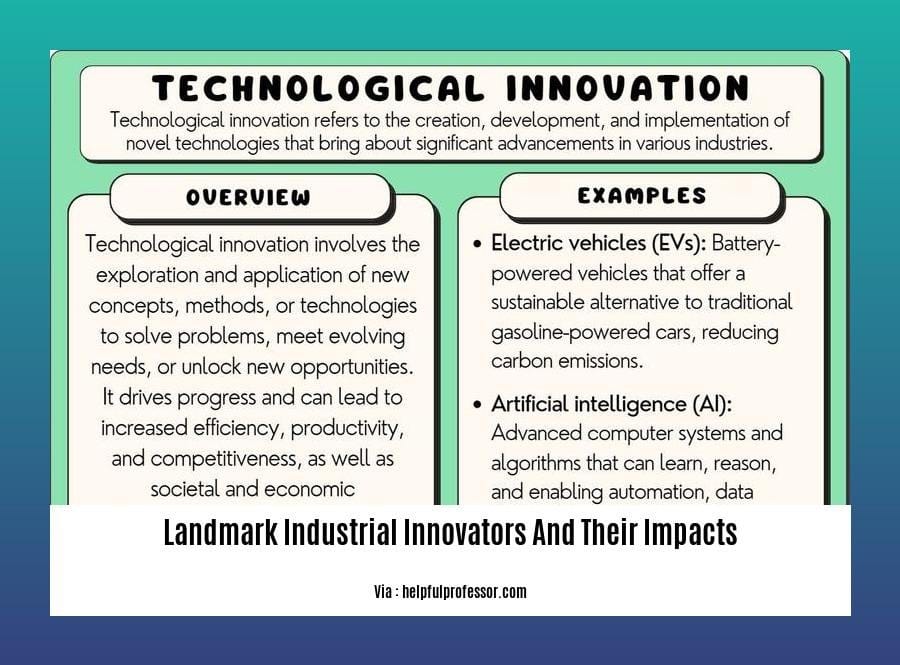The Profound Impacts of Landmark Industrial Innovators: Unveiling the Visionary Minds and Transformative Technologies That Shaped the World

Key Takeaways:
- Technological innovation is essential in competition between major powers.
- The US has a rich history of supporting innovation, such as through the National Defense Education Act.
- Politics and political views can hinder innovation and technological advancements.
- The National Science Foundation (NSF) has made substantial investments in basic research and civilian science.
- Changing workforce, evolving business ecosystems, and digital disruptions are driving industrial transformation.
- Innovation requires both behavioral and production perspectives.
- Companies must embrace testing new technologies and committing to dominating new products to drive innovation.
Landmark Industrial Innovators and Their Impacts
Landmark industrial innovators have made immense contributions to shaping the modern world, driving technological advancements and transforming industries. These visionaries have revolutionized production processes, created new materials, and improved our quality of life.
Technological Innovation and Industry Transformation
The industrial sector is constantly evolving, driven by factors such as a changing workforce, evolving customer demands, and digital disruptions. Landmark industrial innovators have played a pivotal role in this transformation, introducing new technologies and business models.
Historical Perspectives on Innovation
Innovation has played a significant role in great power competition throughout history. The United States’ National Defense Education Act (NDEA) and the creation of the National Science Foundation (NSF) underscore the importance of government investment in research and development.
Impact of Landmark Industrial Innovators
Landmark industrial innovators have left a lasting legacy on various industries:
- Steam Engine: James Watt’s steam engine revolutionized transportation and manufacturing, fostering the Industrial Revolution.
- Electricity: Thomas Edison’s inventions, including the electric light and power grid, transformed urban life and industry.
- Automobile: Henry Ford’s mass production techniques made automobiles affordable for the average person, shaping modern transportation.
- Computer: The development of the computer by Charles Babbage, Alan Turing, and others ushered in the digital age.
Role of Behavioral and Production Innovation
Innovation encompasses both behavioral and production perspectives. Firms that foster a culture of experimentation and embrace new products and technologies are more likely to drive innovation.
Conclusion
Landmark industrial innovators have profoundly impacted society, transforming industries, improving our daily lives, and driving economic growth. Their vision and ingenuity continue to inspire future generations of innovators, shaping the future of industry.
Discover the extraordinary tales of the groundbreaking industrial pioneers and visionaries who engineered entirely new paradigms of efficiency and productivity, forever altering the tapestry of human civilization. Read their captivating stories here, and explore the catalysts whose innovations triggered industrialization here. Finally, learn about the pioneers who sparked industrial revolutions here.
Alexander Graham Bell and the Invention of the Telephone
Alexander Graham Bell’s invention of the telephone in 1876 permanently altered the communication landscape. His groundbreaking innovation has seamlessly woven into the fabric of our lives, establishing real-time conversations across vast distances.
Bell’s Contributions Beyond Telephony:
Beyond his groundbreaking work on telephony, Bell’s scientific curiosity led him to make notable contributions in diverse fields. He actively pursued groundbreaking research in audiology, aeronautics, and medicine, leaving an indelible mark on these disciplines.
Key Takeaways:
- Revolutionized Communication: Bell’s invention of the telephone initiated a communication revolution, forever transforming the way people connect across distances.
- Co-founded AT&T: Bell’s pivotal role in co-founding AT&T played a crucial role in establishing global telephone networks.
- Scientific Exploration: Bell’s scientific endeavors extended far beyond telephony, demonstrating his versatility and unwavering commitment to scientific exploration.
Citation:
* Alexander Graham Bell
George Eastman and the Creation of the Kodak Camera
Ever wondered how photography became accessible to the masses? Enter George Eastman, the visionary behind the Kodak camera. His invention simplified the cumbersome processes of photography, making it convenient and affordable for everyone.
Key Takeaways:
- Eastman simplified photography by introducing roll film and box cameras.
- Kodak’s innovations brought photography from the hands of professionals to the general public.
- The company’s impact on the industry revolutionized visual communication and documentation.
In the late 19th century, photography was a complex and expensive pursuit, limited to professionals. Eastman’s genius lay in breaking down this barrier. He replaced fragile glass plates with flexible roll film, making it easier to capture moments on the go. His box cameras were compact and user-friendly, allowing anyone to take pictures without technical expertise.
The creation of the Kodak camera was a turning point. It democratized photography, making it an accessible form of self-expression and documentation. Kodak’s slogan, “You press the button, we do the rest,” captured the essence of Eastman’s vision: to make photography effortless and enjoyable.
Eastman’s legacy extends far beyond the Kodak camera. His innovations laid the foundation for today’s digital photography, where capturing and sharing images have become an integral part of our lives.
Citation:
- American Chemical Society. (2022, October 3). George Eastman, Kodak, and the Birth of Consumer Photography.
Nikola Tesla and his contributions to electricity
Nikola Tesla was a Serbian-born American inventor, electrical engineer, mechanical engineer, and futurist who is best known for his contributions to the design of the modern alternating current (AC) electrical system.
Tesla’s work helped usher in the age of electricity, and his inventions and theories continue to be used in our electrical systems today.
Key Takeaways:
- Nikola Tesla invented the alternating current (AC) electrical system, which is the backbone of our modern electrical infrastructure.
- Tesla’s work on the Tesla Coil and induction motor advanced electrical technology and paved the way for countless technological advancements.
- Tesla’s impact on electrical engineering was enormous, with his AC motor and polyphase AC system forming the basis of modern power generation and distribution.

FAQ
Q1: How has Alexander Graham Bell’s invention of the telephone impacted society?
Q2: What significant contributions did George Eastman make to the field of photography?
Q3: How did Nikola Tesla’s invention of the alternating current (AC) electrical system revolutionize power distribution?
Q4: What historical factors have influenced the development of innovation and technology in the United States?
Q5: How are digital disruptions and other factors driving the transformation of the industrial sector?
- Unlock Water’s Symbolism: A Cross-Cultural Exploration - April 20, 2025
- Identify Black and White Snakes: Venomous or Harmless? - April 20, 2025
- Unlocking Potential: Origins High School’s NYC Story - April 20, 2025















